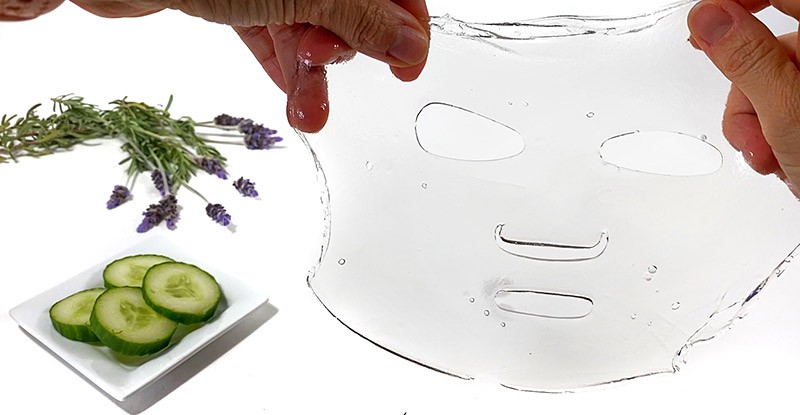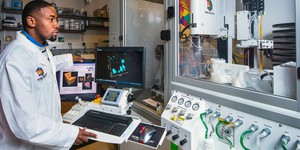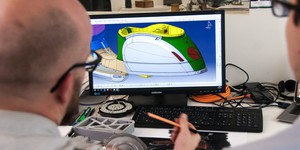Abstract
Have you ever tried a beauty face mask? Cosmetic face masks are skin care products that promise rapid hydration of your skin to make it look younger and more radiant. Hydrogel face masks are made of jelly-like materials that are infused with special ingredients to nurture your skin. The ingredients for cosmetic products like face masks are carefully selected by cosmetics chemists. Each product is designed to have the properties that are necessary for its intended purpose. In this science project, you will become a cosmetics scientist and use the engineering design process to create your own hydrogel face mask recipe. Can you make a hydrogel face mask that meets all your desired criteria?Summary
Objective
Define desired properties for a hydrogel face mask, then develop a face mask recipe that meets those criteria.
Introduction
Did you know that your skin is your body's largest organ? It makes up about 15% of your body weight! Your skin is very important: it prevents germs from entering your body, helps control your body temperature, and allows you to feel things by touching them.
One important way to care for your skin is to keep it hydrated. Skin hydration refers to how much water is in your skin. Water is necessary for skin to be healthy and function normally. Without enough water, skin can become irritated and inflamed, or even crack, as shown in Figure 1. When your skin is dehydrated, it also loses its elasticity, which means it becomes less stretchy. As a result, its lines and wrinkles become more visible and the skin starts to look dull and old.
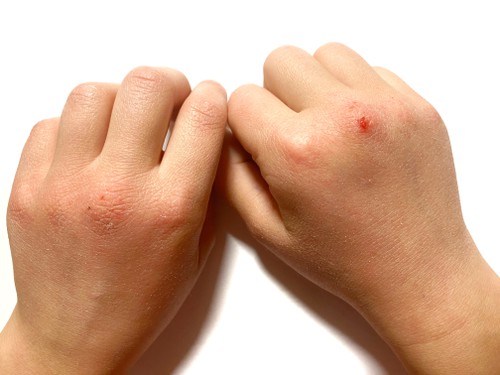 Image Credit: Pixabay user / Pixabay LIcense
Image Credit: Pixabay user / Pixabay LIcense
Figure 1. Chapped, cracked hands demonstrate the effects of dehydration.
The cosmetics industry has developed many skin care products that promise to hydrate the skin. They come in forms like moisturizers, lotions, creams, serums, oils, and gels. Another popular cosmetic product for hydration is a facial mask. Facial masks are sold as a quick treatment for the skin on your face. They are typically only meant to be left on the skin for 15–20 minutes. There are different types of facial masks, including wash-off masks, sheet masks, and hydrogel masks, all shown in Figure 2.
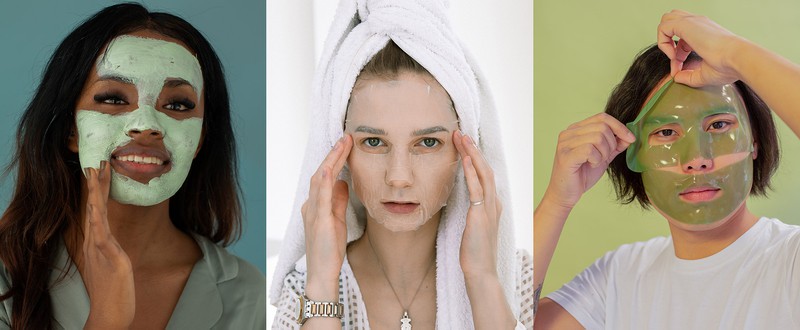 Image Credit: https://www.pexels.com/license/
Image Credit: https://www.pexels.com/license/The wash-off mask is a green, paste-like substance that is spread on the face. The sheet mask is made of a thin, papery material that adheres to the skin when wet. The hydrogel mask is made of a stretchy gelatinous material that clings to the face.
Figure 2. Face masks—including wash-off face masks (left), sheet masks (middle), and hydrogel masks (right)—promise to hydrate your skin.
Hydrogel face masks were first developed in the 2000s, when hydrogel technology was fairly new. Hydrogel is a jelly-like material that can hold a lot of water. It is made of special polymers — long chains of molecules — that can absorb and retain a lot of water. You might be familiar with hydrogels in the form of water gel beads (shown in Figure 3), which grow significantly in size when put in water.
Hydrogels are used in a variety of applications, including medicine and agriculture. In medicine, they can be used as wound dressings or to deliver drugs to the body. In agriculture, hydrogels can be used to help retain water in the soil to improve plant growth. Because hydrogels are able to hold large amounts of water, they are very useful in situations where water needs to be stored or delivered in a controlled manner.
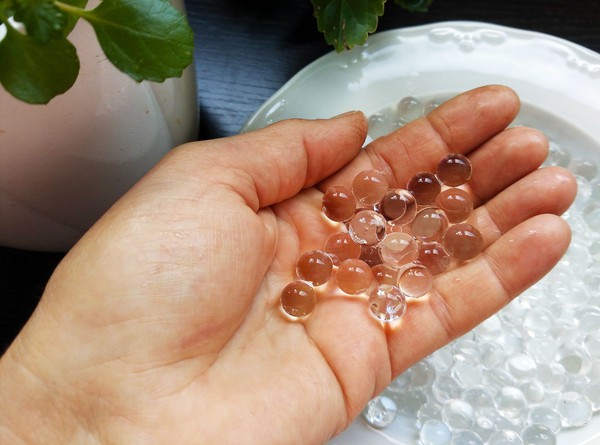 Image Credit: Pixabay user / Pixabay LIcense
Image Credit: Pixabay user / Pixabay LIcense
Figure 3. Water beads that grow when put in water are examples of a hydrogel.
In cosmetics, hydrogels are often used in masks designed to hydrate the skin. There are many different hydrogel face masks on the market. In this science project, you will follow the Engineering Design Process to make your own version of a hydrogel face mask.
Cosmetics chemists choose from thousands of ingredients when they create new products. They are careful to select ingredients whose chemical properties enhance the look, feel, and function of the product they are making. For instance, a face mask that feels dry or breaks easily would probably not be very desirable. A good mask will be stretchy enough to allow you to handle it easily and put it on your face without breaking it.
There are several polymers you can use to make a hydrogel, including collagen, gelatin, and agar agar. The type of polymer you use for making your hydrogel face mask will determine the mechanical properties of your mask.
Hydrogel face masks are usually infused with special ingredients that are supposed to be good for the skin. These ingredients vary depending on the purpose of the mask. Since the main goal of most face masks is skin hydration, the masks are usually made with special hydrating ingredients called humectants. Humectants are substances that pull water from the environment into the skin. They are good at holding onto water, like a sponge. Common humectants include glycerin and hyaluronic acid. You will have to decide on the type and amount of humectants in your face mask.
A good way to test the hydrating effect of your face mask is to measure your skin moisture before and after using a skin moisture detector. Skin moisture content is often reported as a percentage (%). The moisture tester classifies a skin moisture content between 30% and 45% as normal. Since this is a relatively narrow range, a change of just 1–2% in skin moisture can make a big difference.
Your mask also has to be skin-friendly. One way to measure skin-friendliness is to look at the product's pH. The optimal pH for the skin is between 4.7 and 5.7, which is mildly acidic. Ingredients that are too acidic can throw off your skin's pH balance, which could harm your skin.
What other properties do you want your face mask to have? It is up to you to decide! There are plenty of face mask ingredients that you can experiment with. Some of these ingredients include vitamins, oils, herbs, and fruit extracts. Just make sure the ingredients you choose are safe for your skin and safe to handle. You can find resources for learning about different face mask ingredients and their purposes in the Bibliography.
Don't forget to test whether your face mask meets all your requirements and has your desired properties. You will need to come up with some quantitative or qualitative tests to evaluate your recipes. A couple of tests are suggested in the Procedure section. Once you have tried a variety of face mask recipes, you may wish to call in a test panel so you can evaluate their preferences.
Terms and Concepts
- Hydration
- Elasticity
- Hydrogel
- Polymer
- Engineering Design Process
- Collagen
- Gelatin
- Agar agar
- Mechanical Property
- Humectant
- Glycerin
- Hyaluronic acid
- pH
Questions
- Why is it important to keep our skin hydrated?
- How do face masks help hydrate the skin?
- What are hydrogels, and what are their applications?
- Which properties are important for a hydrogel face mask?
- What are some common face mask ingredients, and what are their purposes?
Bibliography
- Dr. Winter. (2016, March 7). The Importance Of Keeping Your Skin Hydrated. Dermatology Center of Washington Township. Retrieved March 14, 2023.
- Chao, J. (n.d.). The Ultimate Guide to Sheet Mask Ingredients. Glowieco.com. Retrieved March 14, 2023.
- Frothingham, S. (2022, March 31). Is Glycerin Good for Your Skin & Face? Healthline. Retrieved March 14, 2023.
- Carpenter, K.G. (2022, November 21). Explainer: What is a hydrogel? Science News Explores. Retrieved March 14, 2023.
Materials and Equipment
As this is an engineering design project, the exact list of materials you need may vary slightly. To make a basic face mask recipe, you will need the following:
- Stove
- Pot
- Measuring spoons
- Distilled water, available in the bottled water section of most grocery stores
- A polymer that makes a hydrogel, like collagen tablets for face masks (about 1.3 g each), agar agar powder, or gelatin. Note: the collagen tablets are for face mask making only. They cannot be eaten!
- Face mask mold
- Spoon
- Timer
- Sharp knife
You can also try various additives to change the properties of your face mask.
- Humectants, such as glycerin or hyaluronic acid
- Herbs or plant extracts, such as aloe vera, green tea, chamomile, hibiscus, or rose
- Oils, such as tea tree oil, jojoba oil, or olive oil
- Essential oils, such as lavender, orange, peppermint, or eucalyptus
- Fruit extracts from pineapple, apple, blueberry, lemon, or strawberry
- Vitamins, such as vitamin B3, B5, B6, C, and E
For skin moisture measurements, you will need:
- Tap water
- Soap
- Skin moisture detector. One example is the MiLi Smart Skin Moisture Detector. This device requires the download of an app.
- Pen or pencil
- Lab notebook
You will need these additional materials for the tests suggested in the Procedure section. However, you are free to come up with your own testing procedures.
- Container with lid
- pH test strips
- Scissors
- Metric ruler
- Digital scale with 0.1 g precision
- Calipers
Disclaimer: Science Buddies participates in affiliate programs with Home Science Tools, Amazon.com, Carolina Biological, and Jameco Electronics. Proceeds from the affiliate programs help support Science Buddies, a 501(c)(3) public charity, and keep our resources free for everyone. Our top priority is student learning. If you have any comments (positive or negative) related to purchases you've made for science projects from recommendations on our site, please let us know. Write to us at scibuddy@sciencebuddies.org.
Experimental Procedure
Making the Hydrogel Masks
- If you have not done so already, research hydrogel face masks and their different ingredients and recipes online. The following instructions and the Make Your Own Cosmetic Face Mask video will give you an idea of how to make a basic hydrogel face mask. In the video, collagen is used to make the hydrogel; however, you can also use other polymers, like agar agar powder or gelatin. Knowing how to make a hydrogel face mask will be a good starting point for your face mask research. Before you actually start making your first face mask, complete your research and then continue with the following steps until you get to step 5, where you make your mask.
- Place the face mask mold on a flat surface that can tolerate spills and heat.
- Add 5 tablespoons of distilled water to the pot.
- Place the pot on the stove and put the lid on. Bring the water to a boil.
- Remove the pot from the stove and add the hydrogel polymer to the hot water. (In the video, this is one collagen tablet.) Swirl the water until the hydrogel polymer has fully dissolved. Note: It is ok if some tiny bits are still floating around.
- Pour the face mask.
- While the liquid is still hot, carefully pour it into the face mask mold. When pouring, move the pot over the mold, so the liquid gets into all areas of the mold.
- Use a clean spoon to spread the liquid in the mold. Make sure the whole mold area is covered. You can also shake or tilt the mold a little to help the liquid spread out.
- Note: Depending on your hydrogel polymer, you may have to be quick in this step, as the liquid will start to become solid. You need to spread it out in the mold before this happens. If the liquid solidifies before you are able to spread it out in the face mask mold, you have to discard the face mask and make a new one. You can also try to reheat the face mask until it dissolves again; however, this doesn't work for all hydrogel materials. One way to prevent early solidification of your mask is to place the face mask molds on a warm or hot surface, such as a warm baking tray. If you do this, make sure the surface is flat. Otherwise, the liquid will spill out of the mask mold.
- Set a timer for 15 minutes and wait for the mask to fully solidify.
- Define criteria for your face mask's properties. For example:
- How stretchy should the face mask be?
- What should the face mask look like?
- What pH should the face mask have in order to be skin-friendly?
- How thick should the face mask be?
- How heavy should the face mask be?
- How hydrating should the face mask be?
- How much water should the hydrogel face mask be able to hold?
- How long should the face mask last when stored?
- What consistency should the face mask have?
- Define how you will evaluate your face mask's properties. You will have to come up with a test to evaluate each property. Some of the properties and observations may be qualitative: for example, the look and feel of the face mask. Other properties can be measured quantitatively. Table 1 gives some examples of quantitative properties and how you can measure them. Make sure you do three trials of each measurement. This is good scientific practice and ensures that you can trust your results.
| Property | Testing Procedure |
|---|---|
| Water holding capacity (swelling index) |
|
| pH |
|
| Face mask shrinkage; relevant for storage |
|
| Hydrating effect |
|
| Stretchiness (elongation percentage) |
|
| Face mask weight |
|
| Face mask thickness |
|
- Based on your background research, write down a face mask recipe that you think will meet all your desired criteria.
- Follow the recipe to make the face mask. When you are done, observe and test your face mask's properties and record them in a data table like Table 2.
Table 2. Example data table.Face mask # Recipe Face mask properties 1 2 3 ...  Notes for face mask application:
Notes for face mask application:
- When you put on the face mask, do not cover your nose or mouth with the face mask. You still need to be able to breathe while wearing the mask.
- The face mask should only be applied for 10-15 minutes.
- Very rarely, people can be allergic to collagen. If you feel a burning, tingling, or itching sensation when the face mask is on your face, remove it immediately and rinse your face with warm water and soap.
- Evaluate whether your face mask's properties exactly match the criteria you defined in step 3. If the face mask does not meet all your requirements, it is time to iterate. This is an important part of the engineering design process. Make changes to the face mask recipe, try again, and evaluate how its properties change.
- In general, it is important to change only one thing at a time. If you change two ingredients at once, you might not be able to tell which one resulted in a property change.
- If your recipe did not work at all, or if it came out very different from what you expected, you may need to go back to the beginning or make more dramatic changes.
- Continue to make changes to your face mask recipe based on your observations and your knowledge of the purpose of different ingredients. Each time you make a change, follow your new recipe to make another face mask and evaluate its properties.
- Keep iterating and testing new face masks until you have found a recipe that gives you a face mask with all the desired properties.
Ask an Expert
Global Connections
The United Nations Sustainable Development Goals (UNSDGs) are a blueprint to achieve a better and more sustainable future for all.
Variations
- During your project, you might come up with several face mask recipes that you like. Do "product testing" for your face mask. Gather a couple of volunteers as a test panel and have them evaluate your different recipes. Which is their favorite? Can you identify specific face mask preferences? Use your test panel's feedback to help you iterate and improve your face mask recipes.
- If you like making your own cosmetic products and testing them, you might also want to try the following Science Buddies projects:
- Compare your own hydrogel face masks with hydrogel face masks that you can buy. How are they similar or different?
Careers
If you like this project, you might enjoy exploring these related careers:
Related Links
- Science Fair Project Guide
- Other Ideas Like This
- Cosmetic Chemistry Project Ideas
- Chemistry Project Ideas
- My Favorites


